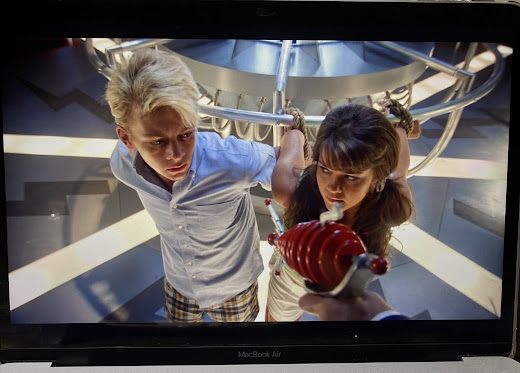Hey guys!!
Teen Beach Movie was my favorite movie growing up and is still one of my favorite movies now.
So, I decided to watch it for the millionth time, but this time paying attention to the different shots and angles used throughout the movie to portray specific feelings :D
Extreme wide shot:
This shot is shown near the very beginning of the movie. It shows the two main characters, Brady and Mackenzie, walking along the beach after surfing. Extreme wide shots are often used to show surroundings. This is displayed in this shot, as you can barely see Brady and Mack, but you can see a lot of the sand, water, trees, and the sunset that surrounds them. I think this shot was used to capture the full beauty of the beach and give off that summery feeling in this scene. Additionally, extreme wide shots are also used to tell the viewer where the following scenes take place. It provides them with context and a better understanding of the plot.
High-angle shot:
This shot is a high-angle shot. In this scene, Brady and Mack are captured and tied up by the two villains Les Camembert and Dr. Fusion. Les Camembert points a stun gun at Brady and Mack as the camera is angled downward. High-angle shots are usually used to make characters look powerless, vulnerable, and weak, as displayed in this shot. Additionally, this shot also establishes dominance within the villains, emphasizing their strength and ill will. These factors are all combined in this shot to portray a tense and suspenseful feeling to the viewer in this scene.
Close up:

This is a close-up shot of Mack when she is about to surf her biggest wave. The shot frames her face at close range and fills the screen, limiting or eliminating distractions in the background. It is used to capture her emotions and show greater detail in her facial expression. In this particular shot, her determination and readiness to take on the challenge of surfing the huge wave is communicated to the viewer. It also helps the viewer understand her state of mind. This helps to express and reflect that boldness and confidence Mack feels onto the watchers themselves. Additionally, this close-up emphasizes the importance of Mack in the entire scene and tells the viewer she is the main focus, while also helping to build up to an event significant to the plot of the movie.
Over-the-shoulder shot:
This is an over-the-shoulder shot of Mack and Brady. The camera is positioned behind Mack, showing only the back of her head which faces the audience, while Brady's face is displayed clearly. This overall scene is a dialogue scene, which over-the-shoulder shots are typically used for, and this particular shot helps to focus on one person at a time along with the conversation. The shot also helps to capture the point of view of both Brady and Mack as they talk to one another. Additionally, over-the-shoulder shots show the reactions and emotions of each character, as the characters are switched between when they speak. This is displayed in this shot, as you can tell Brady has a confused look on his face. This shot aids in the audience's understanding of the dialogue and displays the relationship dynamic between Mack and Brady. Each of these components works together in the shot to display a tense and perplexed feeling.
Two shot:
This is a two-shot of Mack and Brady. Two shots are typically used to show emotional reactions. This is displayed in this shot, as both characters have a look of shock on their faces when they realize they are stuck in a movie. Additionally, two shots help to build suspense up to the reveal of what is going on. Although the shot shows Mack and Brady with taken-aback expressions, we do not know what they are looking at that makes them react this way. This shot along with other factors evokes an intriguing and on-edge feeling.






No comments:
Post a Comment